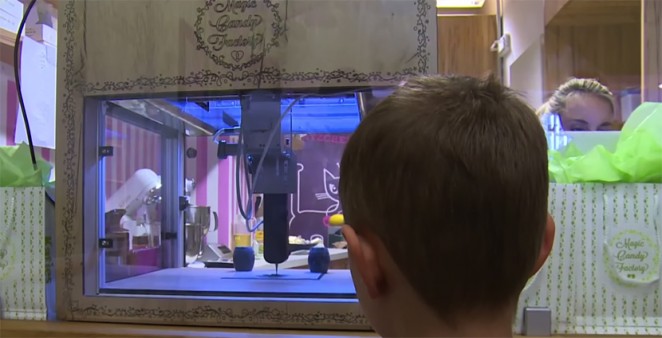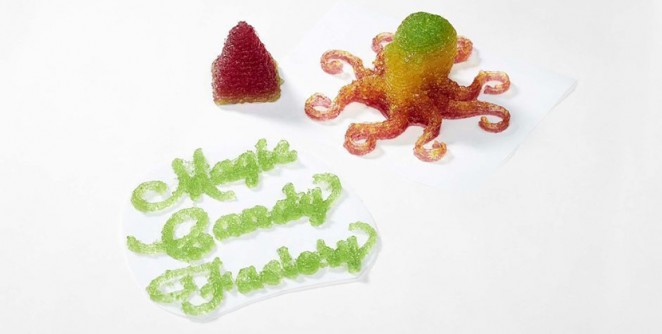In the last few years, 3D printing has evolved from a niche concern into a thriving industry, with many previous naysayers in the design community now happily jumping on board the bandwagon with both feet. Not only is it a surprisingly affordable and significantly faster and more convenient way in which to bring your designs to physical life, but it's an incredibly flexible tool with so much more to offer than just the ability to create quick and easy prototypes. However, as aware as I have become of the opportunities afforded by modern 3D printers, I was totally unprepared for this.
German confectionary company Katjes, have revealed a new 3D printer specifically designed to print fruit gum sweets

The German confectionary company Katjes, recently revealed a new 3D printer specifically designed to print fruit gum sweets! Called the “Magic Candy Factory,” there is currently only one such printer, which is located at the Cafe Grün-Ohr in Berlin, and is the first 3D printer for food to be made available for public use. Operating in much the same way as a conventional 3D printer, only substituting plastic resin for candy, the device heats up the candy ingredients allowing them to flow through the syringe pump and print out thin strings of delicious gummy yumminess. Once on the build plate below, the candy then cools and hardens in layers to create simple 3D shapes. Each roughly 10 gram piece of candy takes around five minutes to print, and users can use an iPad to customise their creations. Pre-set shapes include unusual designs such as frogs or octopuses, as well as more classic shapes such as hearts. Currently, there are 20 different designs with 7 different choices of colour and 10 flavour combinations, including sweet sour. In addition, customers can also be able to print personalised greetings on gummy cards to create unique gifts.

The shapes have been developed using 3D modelling software and specially created ‘g-codes’ that tell the printer where to deposit the materials, and at what speed and frequency. The colours and matching flavours were developed in the Katjes R&D lab and can be used either alone or in a combination rainbow option. For the future, a variety of different colours and flavours are planned that will also be available as seasonal exclusives, and could include options for special occasions such as weddings, birthdays or Christmas.
Each sweet costs around €5, which is obviously far more expensive than your average fruit gum, but with the ability to print your own gummy creations, you’re surely paying more for the experience than the product itself. The ingredients are confidential, but the producers have said they are gluten and lactose free, so vegans and coeliacs can rejoice! The machine is currently in an eight-week public beta, but if it's successful, the cafe hopes to expand its availability in the months to come. The machine will also be available to UK consumers though online, retail and leisure outlets from early next year through the Birmingham-headquartered Katjes Fassin UK.
Each roughly 10 gram piece of candy takes around five minutes to print, and users can use an iPad to customise their creations

Katjes Fassin UK managing director Melissa Snover, said: “The Magic Candy Factory allows consumers to create truly delicious, custom sweets that are also completely natural, vegan and allergen-free – a first for the world market. In addition, the benefit of the experience in store for the whole family is that children and adults can learn about the technology of 3D printing and ingredients in food. Other confectioners haven’t been able to bring anything like this to market, but we’ve spent many months developing this technology to be fast, educational and fun. We’ll be rolling the Magic Candy Factory out across the UK from early next year.”

Of course, this isn't the first 3D food printer. Last year, a company called Natural Machines created a device that 3D prints full meals, from chicken nuggets to pizza to salads. Called “Foodini,” it prints food using edible materials pressed out of stainless steel capsules. After the food is printed, however, it must be cooked like a traditional meal, and thus far it is not available to the public, so in that respect, Katjes have the competition pretty much sewn up. I just can't wait until someone uses it to print the Gummy Venus de Milo!

Benjamin Hiorns is a freelance writer and struggling musician from Kidderminster in the UK.






